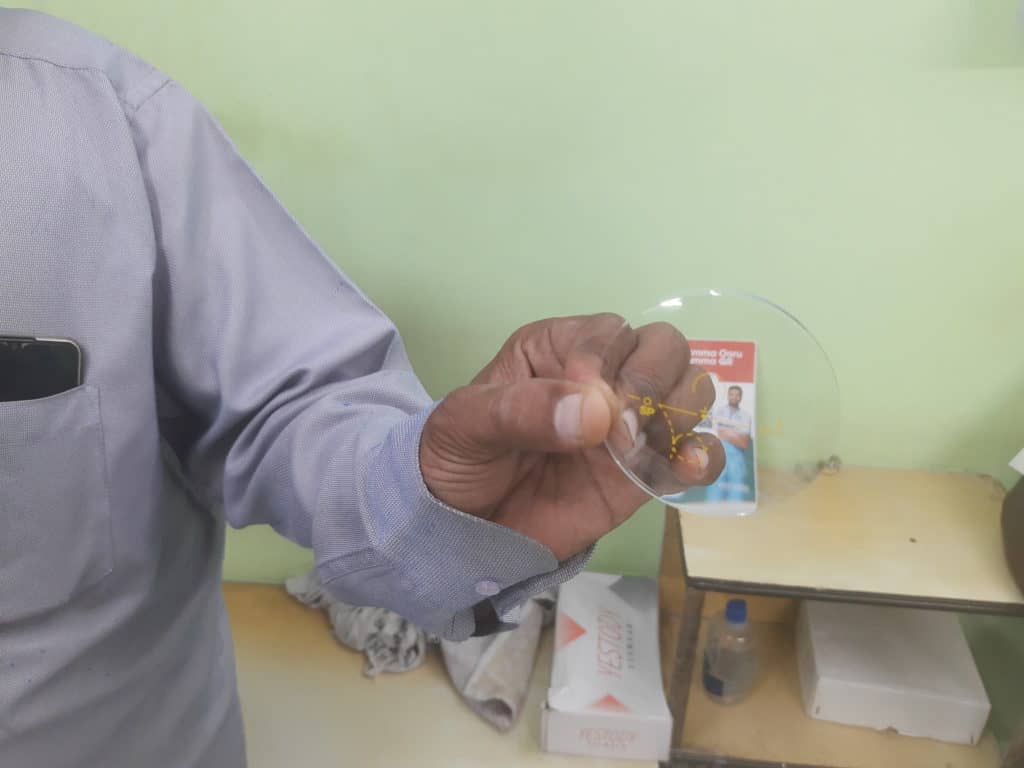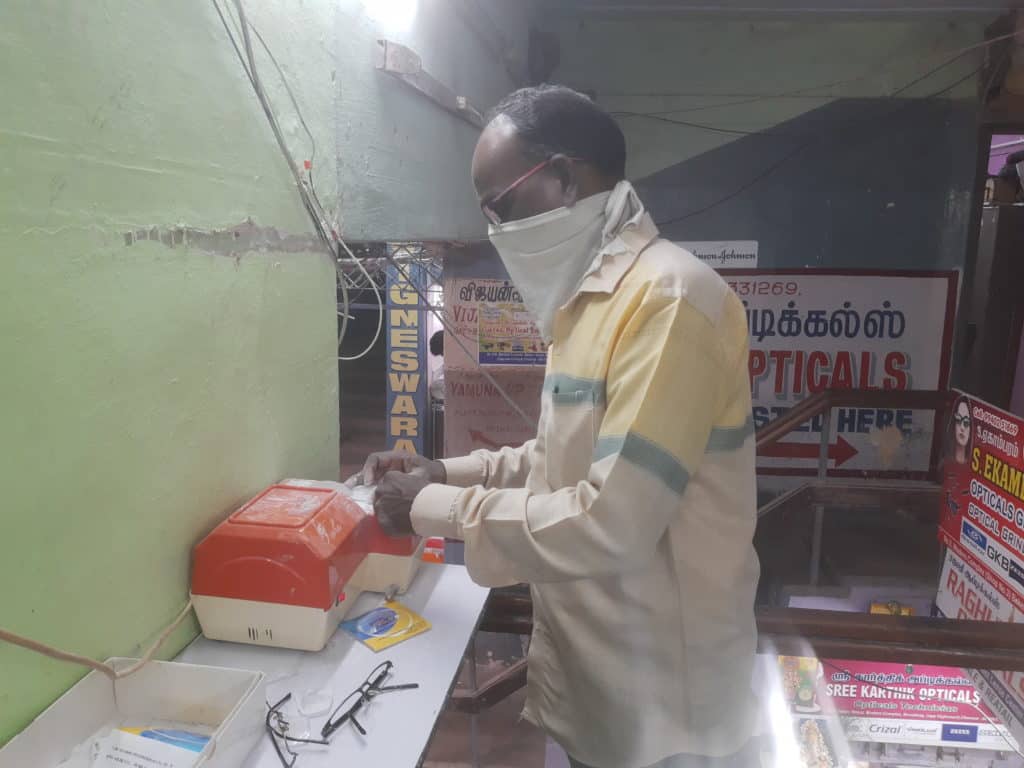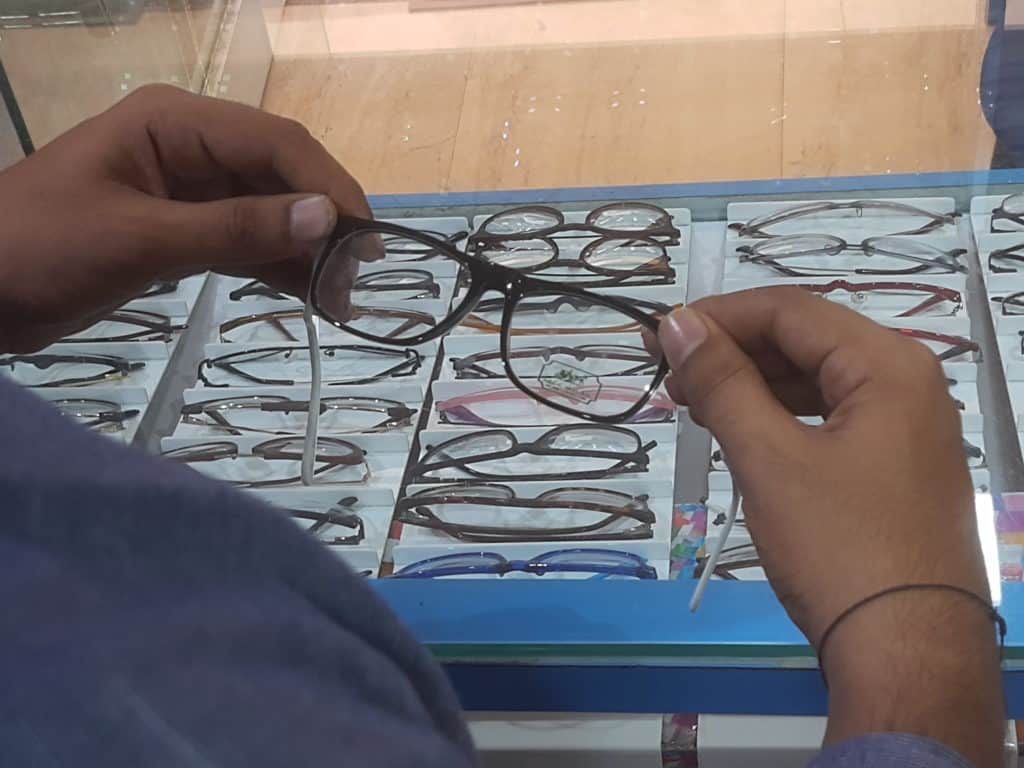Off the busy NSC Bose Road opposite the Madras High Court building, run two streets parallel to each other. On any work day, you would find a stream of loadmen carrying wrapped packages on bullock carts and rickshaws on these streets, even as two-wheelers snake their way in and out and shoppers walk leisurely past. There’s not much to distinguish the streets from any other commercial locality on Broadway just by the looks of it.
The real uniqueness lies elsewhere. These two streets — Prakasam Salai and Baker Street host hundreds of wholesale optical stores. From the cutting of lens to final assembly in a frame, all the work that goes behind a perfect pair of glasses happens at this hub of eye glass-making in Chennai. Grinding and cutting lens is the dominant business on Baker Street, while wholesale and retail stores mark the long stretch of Prakasam Salai.
Famous politicians and actors of yesteryear — including then Chief Minister M G Ramachandran and noted actor Gemini Ganesan — are said to have bought spectacles here. Even today, the colourful lens often used by female negative characters in Tamil soaps are primarily manufactured here.
“Cat-eye lenses or lenses with radiating colours that we commonly see on villains on screen are dirt cheap here,” says Ganapathy T, who works in an optical store.

Compared to the markets of Sowcarpet, Prakasam Salai and Baker Street are much cleaner. However, traffic congestion, constant honking of vehicles and haphazard parking of vehicles pose a menace here.
Naming of the streets
According to historian V Sriram, Baker Street takes its name from George Baker, who was Mayor of erstwhile Madras in 1773. “A naval captain, George Baker rendered service to the British at Fort St.George when the French laid siege to Madras in 1758,” writes renowned historian V Sriram in an article published in The Hindu.
Prakasam Salai is named after the famed freedom fighter and the first Prime Minister of Madras state after independence, T Prakasam, according to an article in Madras Musings authored by V Sriram.
“When the Simon Commission came to India, a protest march was organised down Broadway. As the procession reached China Bazaar (now NSC Bose) Road, the police opened fire, killing one of the protestors. The body lay at the intersection and the police announced that anyone coming forward to claim it would meet with the same fate. That did not deter T Prakasam, well-known lawyer and patriot. He bared his chest and darted forward. The police realised that the situation could get out of hand and held its fire,” V Sriram wrote in the article.
Read more: Photos: Exploring Chennai’s forgotten heritage in Chintadripet
A tradition for customers
Way before the emergence of new chains and optical stores across neighbourhoods of Chennai, these two streets of Broadway used to be the primary destination of anyone looking to get their eye glasses made in the city. One of the oldest such stores in Chennai, Porwal & Bros Opticians, was established in 1933. It was founded by Ottermal Rajaji Jain and is now managed by the third-generation entrepreneur Praveen Jain.
On a Saturday afternoon in late January, when I visited their store, Praveen Jain was busy talking to customers and guiding his employees. There was a steady stream of customers, some from as far as Porur and Vadapalani, who were visiting the store to get their vision checked and order a pair of glasses.
“Back then in 1933, there were just three to four optical stores in the locality. This used to be such a quiet and sparsely populated area that old-timers will find it difficult to recognise it as the same street. Such has been the extent of development,” said Praveen Jain, recollecting the stories told to him through generations.

But now that there are so many options, isn’t it an unnecessary investment of time to come here from far-off neighbourhoods, just to get a pair of spectacles? Customers such as Senthil Narayanan say that it is more of a tradition. He is perfectly comfortable having to travel around 16 km to the store, for a pair of reading glasses! “Ever since I first started using glasses, I have been a loyal customer at Porwal,” smiled Senthil, who relocated to Porur, a decade ago.
The business of frames
The opticians’ business in Chennai is dominated by those who have migrated from Rajasthan, Bihar and West Bengal and set up ventures here. According to M S Davey, Vice-president of Madras Opticians Association, there are about 350 opticians in Prakasam Salai and Baker Street today. They buy frames and lenses from the wholesale markets of Bombay and Delhi at a very cheap price.
From local to western, trendy to antique, rugged to subtle — you get every kind of frame on sale in these streets. Customer preferences keep changing, of course. Gold-coloured frames, square-shaped wood metallic ones were the fad two decades ago. Now, the circular, matte frames popularly called Gandhi kannadi seem to be the craze.
“I make bulk purchases at Prakasam Salai. A pair of prescription glasses that cost Rs 2000 in a retail store can be bought for Rs 1000 here, without compromising on the quality,”
Renjini Raj, a trader from Kerala.
“15 years ago, we used to import branded frames such as Corning and Rodenstock from France and Germany. Today it has become a bit easier for us to source these. The import and distribution of these foreign brands have become much more common and we just get them from Bombay,” Praveen Jain says.
Just like the changing trends in frames, the art and craft of spectacle-making have changed too. After a customer places an order, the lenses are cut to the size of the frame and the edges have to be filed neatly. Before computerised eye testing became the norm, it would take at least an hour to test customers’ vision manually. Then, they would have to wait for a day to receive their pair of glasses. Now, it can be done in just half-an-hour. Get your eyes checked, select a frame, pay the bill, take a walk down the road and collect your pair of glasses on your way back.
But advancement in technology hasn’t brought with it a rise in fortunes for those in the trade. Tying a handkerchief around his face to prevent the smallest of glass particles from entering his nose, S Ekambaram was shaping a large piece of glass to fit into a square frame, when I approached him. Owner of the store, Opticals Grinders, Ekambaram has been in the profession since 1984. “I worked as an assistant initially and earned Rs 15 per week back then. Having learnt the trade, I set up my business and saw good profits that could go upto Rs 10,000 a month. But as competition rose, our profits fell sharply, to less than Rs 7000” said Ekambaram.
A lot has changed in these streets in the past 50 years. However, what remains constant is the undying buzz of customers who flock these streets to get a nice frame of glasses at cheap prices. And in less than an hour!
(All pictures by the author)
Also Read:






It’s still the go to place for quality spectacles. I heard about one of the shops there through an elderly relative of mine who said she’s been buying from there since here childhood. And from then on, I was blown away by the cost to quality ratio. Every time I or my family has to get a new pair of glases, we go there. I changed my glasses every three years, mainly because I got bored of the design. The frames are still of good quality and are just fine. With a lot of options for lenses too, a great pair of spectacles can cost atleast 500 rupees lesser than from the outlets at other parts of city